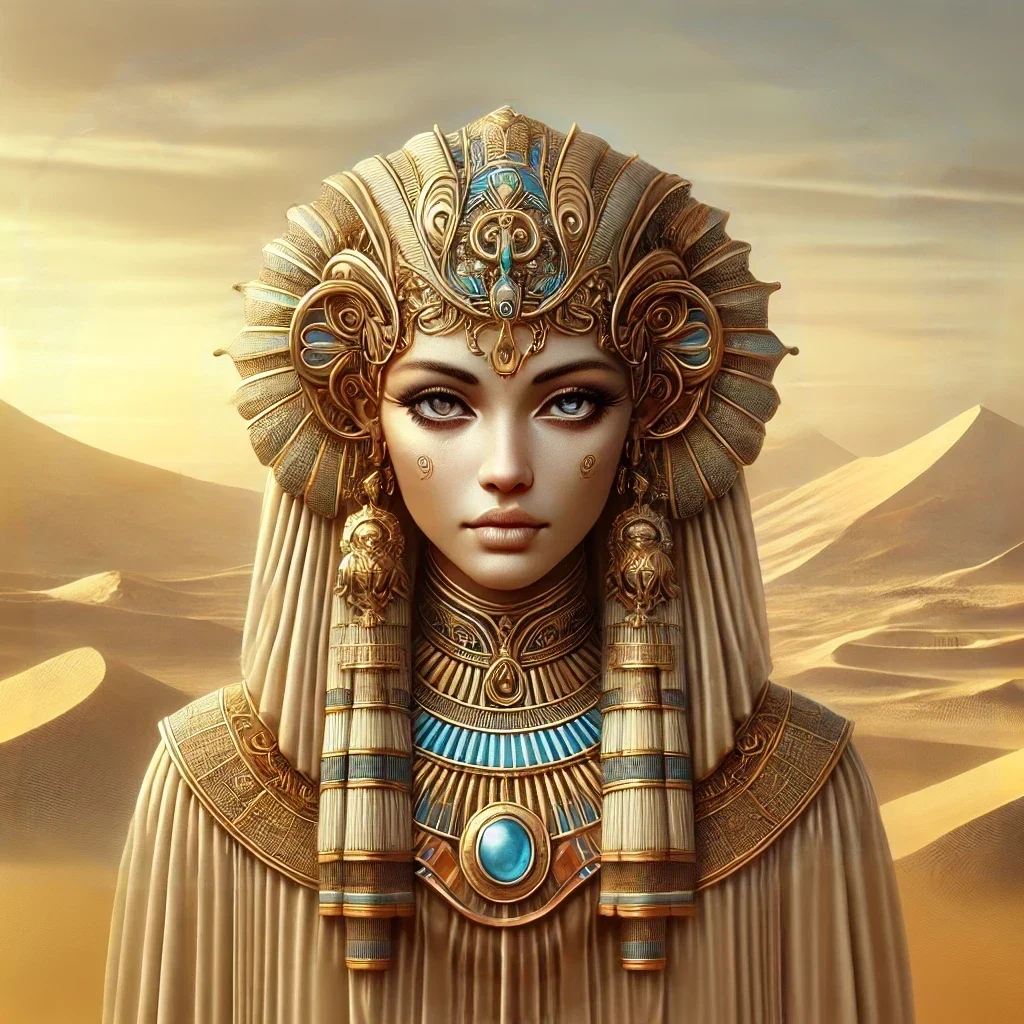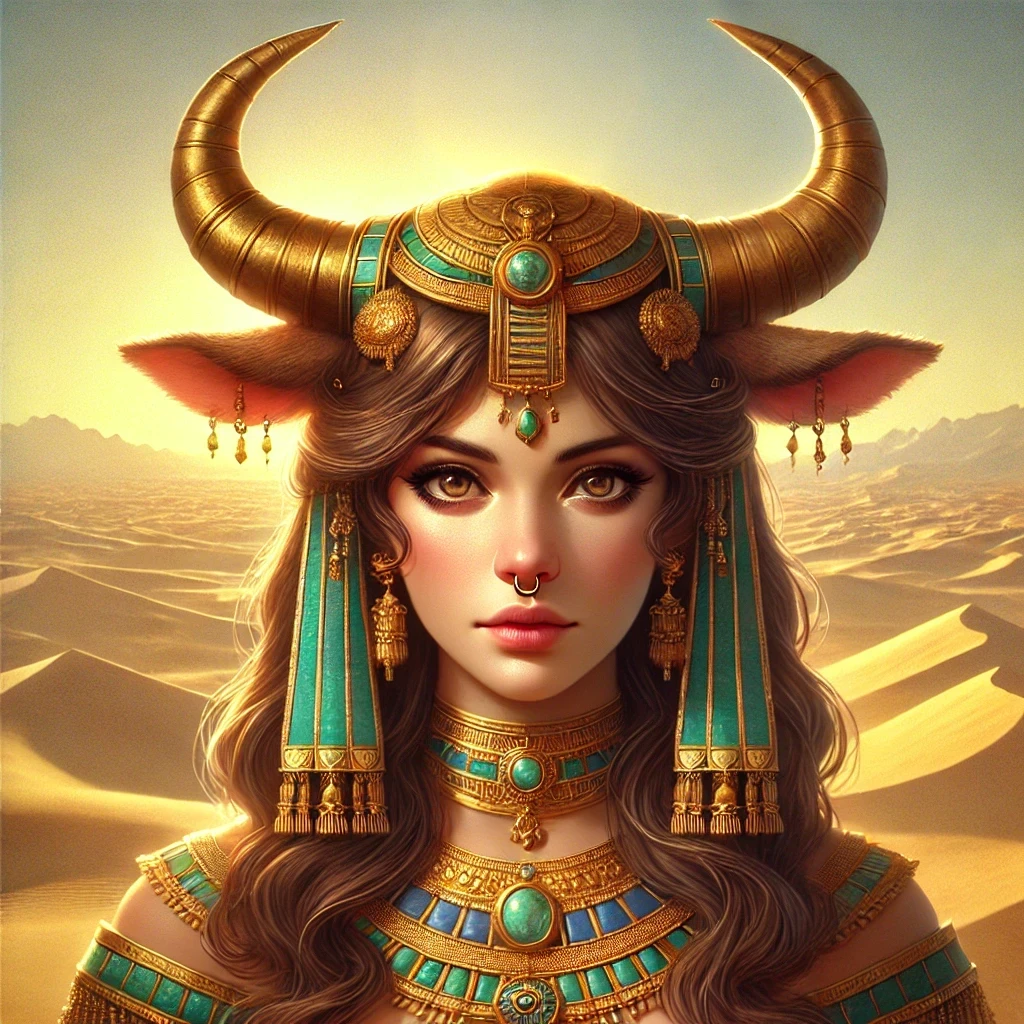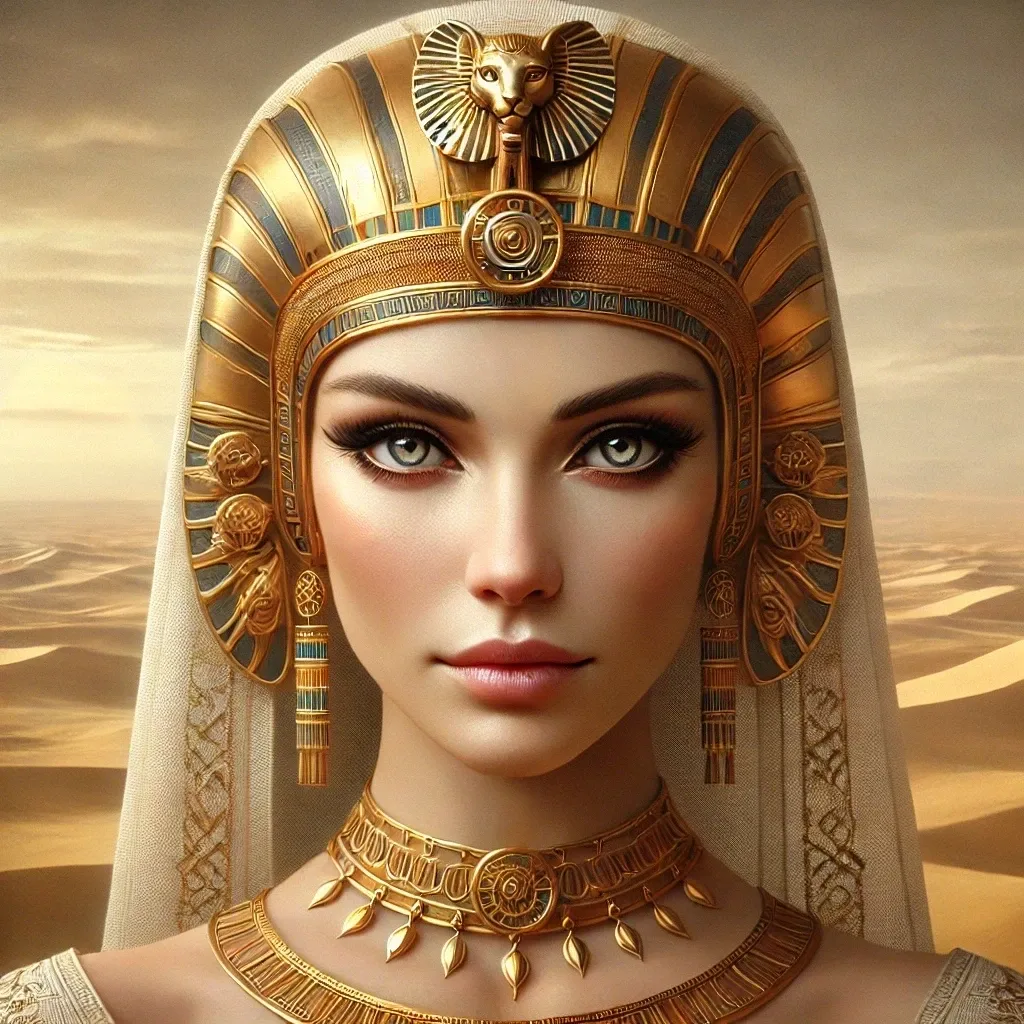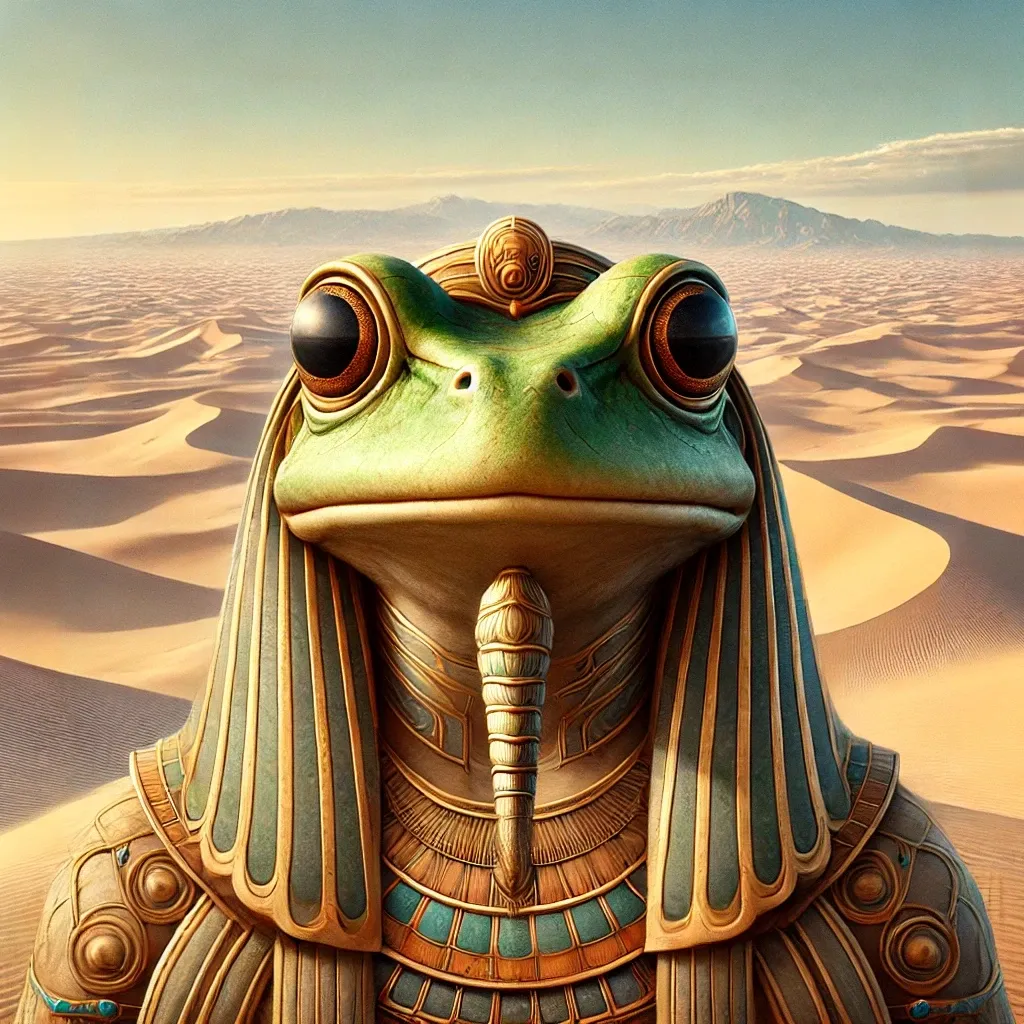Known as one of the eight deities of the Ogdoad, Hauhet represents infinity, eternity, and the boundless expanse of time and space. The name itself, often translated as “Endlessness” or “Infinity,” reflects the deity’s association with the infinite and the formless. Epithets such as “She Who is Without Limit” and “Mistress of Eternity” further emphasize the deity’s role in the cosmic order. Unlike many gods and goddesses who were depicted in human or animal forms, this deity’s representation is deeply tied to the intangible, making their worship and understanding a unique aspect of Egyptian theology. As a primordial force, she was revered not for her physicality but for her embodiment of the infinite, a concept that resonated deeply in the Egyptian worldview.
Origins
The Ogdoad of Hermopolis
The deity’s origins are rooted in the Ogdoad, a group of eight primordial gods worshipped in the city of Hermopolis (modern-day Ashmunein). The Ogdoad represented the chaotic forces that existed before creation, consisting of four pairs of male and female deities, each embodying a fundamental aspect of the pre-creation universe. Hauhet, paired with her male counterpart Heh, symbolized infinity and the endless expanse of time and space. Together, they were part of the cosmic balance that allowed creation to emerge from chaos.
Pre-Creation Cosmology
In Egyptian cosmology, the universe began as a formless, watery void known as Nun. The Ogdoad, including Hauhet, were the forces that existed within this void, their interactions giving rise to the first mound of creation, from which the sun god Atum emerged. This deity’s role in this process was to provide the infinite potential for creation, a concept that was both abstract and essential to the Egyptian understanding of the universe.
Evolution of Worship
While the Ogdoad’s influence was most prominent during the Old and Middle Kingdoms, their worship persisted in various forms throughout Egyptian history. Over time, the deity’s association with infinity and eternity became intertwined with other gods, particularly those associated with time and the afterlife, such as Osiris and Ra. This evolution reflects the adaptability of Egyptian theology, where primordial deities often merged with or influenced later gods.
Appearance
Abstract Representation
Unlike many Egyptian deities, Hauhet was rarely depicted in human or animal form. Instead, their representation was abstract, often symbolized by hieroglyphs or conceptual imagery. The most common symbol associated with them was the hieroglyph for “infinity” or “millions of years,” a looped rope that signified endlessness. This lack of physical form underscores their role as a primordial force rather than a personified deity.
Iconography in Temples
In temple art, the deity was sometimes depicted as a frog or a snake, animals associated with fertility and regeneration in Egyptian symbolism. These depictions were not literal but rather symbolic, emphasizing their connection to the cyclical nature of time and the infinite potential of creation. Occasionally, they were shown alongside their male counterpart, Heh, with both figures holding notched palm ribs, symbols of long life and eternity.
Influence on Later Depictions
As Egyptian theology evolved, the deity’s abstract nature influenced the depiction of other gods associated with time and eternity. For example, the god Heh, often depicted as a man kneeling with arms outstretched to support the sky, borrowed elements from Hauhet’s symbolism, particularly the notched palm ribs and the concept of infinity.
Abilities
Embodiment of Infinity
The deity’s primary ability was their embodiment of infinity, a concept that was central to Egyptian cosmology. They represented the endless expanse of time and space, providing the framework within which creation could occur. This ability was not just symbolic but also functional, as it allowed the universe to exist and expand without limits.
Influence on Creation
As part of the Ogdoad, Hauhet played a crucial role in the process of creation. Their infinite nature provided the potential for the emergence of the sun god Atum and the subsequent creation of the world. Without their presence, the universe would lack the boundless potential necessary for growth and renewal.
Connection to Eternity
In addition to their role in creation, the deity was closely associated with eternity, particularly in the context of the afterlife. They were believed to ensure the eternal existence of the soul, providing the infinite time necessary for the deceased to journey through the Duat (the underworld) and achieve resurrection.
Domain
The Primordial Waters
The deity’s domain was the primordial waters of Nun, the formless void from which all creation emerged. This watery expanse was not just a physical space but also a metaphysical one, representing the infinite potential for life and creation. As a force within this domain, Hauhet embodied the limitless possibilities of existence.
The Cosmic Balance
In addition to the primordial waters, the deity’s domain included the cosmic balance that allowed creation to occur. They were part of the delicate equilibrium between chaos and order, ensuring that the universe remained in harmony. This balance was essential for the continued existence of the world and the gods.
The Afterlife
The deity’s influence extended to the afterlife, where they played a role in ensuring the eternal existence of the soul. Their connection to infinity and eternity made them a vital part of the journey through the Duat, where the deceased sought resurrection and eternal life.
Myths
The Creation of the World
One of the most significant myths involving Hauhet is the creation of the world. According to the Hermopolitan creation myth, the Ogdoad, including this deity, existed within the primordial waters of Nun. Their interactions caused the emergence of the first mound of creation, from which the sun god Atum arose. This myth highlights the deity’s role in providing the infinite potential necessary for creation.
The Journey Through the Duat
In funerary texts such as the Book of the Dead, the deity is mentioned as a guiding force for the deceased. Their infinite nature ensures that the soul has the time and space necessary to navigate the challenges of the Duat and achieve resurrection. This myth underscores their importance in the afterlife and their role in ensuring eternal life.
The Union with Heh
Another notable myth involves the union of Hauhet with her male counterpart, Heh. Together, they represent the infinite expanse of time and space, their union symbolizing the balance necessary for creation. This myth reflects the Egyptian belief in the importance of duality and balance in the cosmos.
Symbolism
The Infinity Hieroglyph
The most prominent symbol associated with Hauhet is the infinity hieroglyph, a looped rope that signifies endlessness. This symbol was often used in temple inscriptions and funerary texts to represent the deity’s infinite nature and their role in ensuring eternal life.
Frogs and Snakes
Frogs and snakes were also symbolic of the deity, representing fertility, regeneration, and the cyclical nature of time. These animals were not literal representations but rather metaphors for the infinite potential and renewal embodied by Hauhet.
Notched Palm Ribs
The notched palm ribs, often held by the deity and their counterpart Heh, symbolized long life and eternity. These objects were used in temple art to emphasize their connection to the infinite and their role in maintaining cosmic balance.
Worship
Temples and Priests
While Hauhet did not have dedicated temples, they were worshipped as part of the Ogdoad in Hermopolis. Priests of the Ogdoad performed rituals to honor the primordial forces, ensuring the continued balance of the universe. These rituals often involved offerings and prayers to maintain the infinite potential represented by the deity.
Festivals and Rituals
Festivals honoring the Ogdoad were held in Hermopolis, celebrating the primordial forces and their role in creation. These festivals included processions, offerings, and recitations of creation myths, emphasizing the importance of the deity’s infinite nature.
Evolution of Veneration
Over time, the worship of Hauhet became less prominent as other gods, such as Ra and Osiris, gained popularity. However, their influence persisted in the symbolism and theology of later periods, particularly in the context of the afterlife and eternal life.
Associations
The Ogdoad
Hauhet’s primary associations were with the other members of the Ogdoad, particularly her male counterpart, Heh. Together, they represented the infinite expanse of time and space, their union symbolizing the balance necessary for creation.
Connections to Other Gods
The deity’s influence extended to other gods associated with time and eternity, such as Ra and Osiris. Their infinite nature was often invoked in rituals and texts related to these gods, emphasizing their role in ensuring eternal life.
Allies and Rivals
As a primordial force, Hauhet had no direct rivals. However, their role in maintaining cosmic balance sometimes placed them in opposition to chaotic forces, such as Apep, the serpent of chaos. This opposition reflected the broader Egyptian struggle between order and chaos.
Legacy
Decline in Worship
The decline of Hauhet’s worship coincided with the rise of other gods and the centralization of Egyptian religion around figures like Amun and Ra. As the focus shifted from primordial forces to more personified deities, the abstract nature of Hauhet made them less accessible to the general population.
Influence on Later Theology
Despite their diminished role, the deity’s influence persisted in Egyptian theology. Their association with infinity and eternity continued to shape the understanding of time, creation, and the afterlife, particularly in funerary texts and temple inscriptions.
Modern Rediscovery
In modern times, Hauhet has been rediscovered by scholars and enthusiasts of ancient Egyptian religion. Their abstract nature and profound symbolism have made them a subject of interest for those studying the complexities of Egyptian cosmology and theology.
Trivia
- The Frog Goddess Connection: While Hauhet was rarely depicted as a frog, the association with frogs in the Ogdoad highlights their link to fertility and regeneration, themes central to their role in creation.
- The Notched Palm Ribs Mystery: The notched palm ribs held by Hauhet and Heh are believed to represent the counting of years, symbolizing their control over infinite time, yet their exact origin and meaning remain debated among Egyptologists.
- A Name Without Pronunciation: The exact pronunciation of Hauhet’s name is uncertain, as ancient Egyptian hieroglyphs did not record vowels, leaving modern scholars to reconstruct it based on linguistic patterns.
- The Ogdoad’s Gender Balance: The Ogdoad consisted of four male-female pairs, emphasizing the Egyptian belief in duality and balance, with Hauhet and Heh representing the perfect harmony of infinity.
- Hidden in Plain Sight: Despite their importance, Hauhet’s name and symbols appear far less frequently in surviving texts and artifacts compared to other deities, making them one of the more elusive figures in Egyptian mythology.
- The Cosmic Egg Theory: Some scholars suggest that the Ogdoad, including Hauhet, were linked to the concept of a cosmic egg, from which the sun god Atum emerged, though this theory remains speculative.
- A Deity Without Temples: Unlike many Egyptian gods, Hauhet had no dedicated temples, as their worship was primarily tied to the collective veneration of the Ogdoad in Hermopolis.
- The Infinity Symbol’s Evolution: The looped rope hieroglyph associated with Hauhet is one of the earliest known symbols of infinity, predating modern mathematical representations by thousands of years.
- A Silent Presence in Art: Hauhet’s abstract nature meant they were rarely depicted in traditional art, making any surviving representations highly significant for understanding their role in Egyptian theology.
- The Forgotten Force: Despite their diminished role in later Egyptian religion, Hauhet’s influence can be traced in the enduring emphasis on eternity and infinity in funerary practices, such as the use of the “millions of years” motif in tombs.



